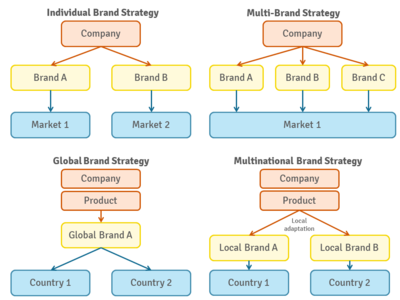Multi brand strategy: Difference between revisions
Ceopediabot (talk | contribs) m (→Advantages and Disadvantages of Multibranding: typos fixed: ofcourse → of course, ’s → 's, full → ful) |
|||
| Line 24: | Line 24: | ||
The huge thing about Multibranding is that each brand can obtain only a small market share, and not all can be very profitable. The company have to spread a lot off recources over many brands instead building a few brands to a highly profitable level <ref> Kotler P., 2015, p.306</ref>. | The huge thing about Multibranding is that each brand can obtain only a small market share, and not all can be very profitable. The company have to spread a lot off recources over many brands instead building a few brands to a highly profitable level <ref> Kotler P., 2015, p.306</ref>. | ||
[[File:brand_strategies.png|400px|right|thumb|Fig.1. 4 brand strategies: multi-brand strategy vs. individual, global and multinational]] | |||
==Multibranding's mission== | ==Multibranding's mission== | ||
Revision as of 09:46, 31 August 2020
| Multi brand strategy |
|---|
| See also |
Multi brand strategy is one of a marketing techniques for two or more similar products from one firm but under different and unrelated brands. The idea of Multi brand strategy is to restrict or end the competition and increase the market share.
Main definition
Steven Hillestad wrote in his book that "The multibranding strategy minimizes risk to the parent organization"[1].
"Multibrand strategy permits finer segmantation of the market, with each brand name suggesting different functions or benefits appealing to different buying motives of different customer segments" [2].
The huge thing about Multibranding is that each brand can obtain only a small market share, and not all can be very profitable. The company have to spread a lot off recources over many brands instead building a few brands to a highly profitable level [3].
Multibranding's mission
Primary objective of this is to secure more shelf/display as well as a broader customer base in retail outlets.
Following the assumption if firm wich has two or more brands would sell more than with a single brand and so on to any number of brands, the idea strengthened by the knowledge that every item the company sells, competitors sell one less [4].
Advantages and Disadvantages of Multibranding
The main advanteges are [5]:
- The Multi Brand Strategy is very useful for brand "switchers" companies, which are keeping on changing brands to trying different products, because having a large product line and multi-brand gives a very big chance, that even after switching the brands, the customer is still associated with the company.
- Successes of initial business ensure that the company can now venture into developing another brand with the profits of the first brand or through the way of franchising.
But also here is the main disadvantage [6]:
- The biggest disadvantage of a Multi Brand strategy is that the company's image may become that of not customer oriented but profit oriented and of course this can damage the reputation of the company in long run.
Multibranding in life
A lot of corporations run Multi brand strategy since they have distant brands running in the market on the same time. Here are a few examples:
- BMW: BMW, Rolls Royce, Mini Cooper;
- Adobe: Adobe Photoshop, Adobe Illustrator, Adobe Lightroom, Adobe Stock;
- LVMH: Louis Vuitton, Givenchy, Guerlain, Moët & Chandon, Hennessy and others.
Footnotes
References
- Bhasin H., (2019) What is Multi Brand Strategy? Types and Examples
- Durmaz Y., (2016) Brand and Brand Strategies Canadian Center of Science and Education
- Hillestad S., (2004) Health Care Market Strategy: From Planning to Action Jones & Bartlett Learning, pages 168-172
- Kotler P., (2008) Principles of Marketing Pearson Education, pages 530-540
- Kotler P. and others, (2015) Marketing, 9th Edition Pearson Higher Education AU, pages 306-307
- Papantoniou P., (1992) Marketing: The Complete Awakening P.A.S.S. Publications, pages 142-145
Author: Valentyna Ilyina
